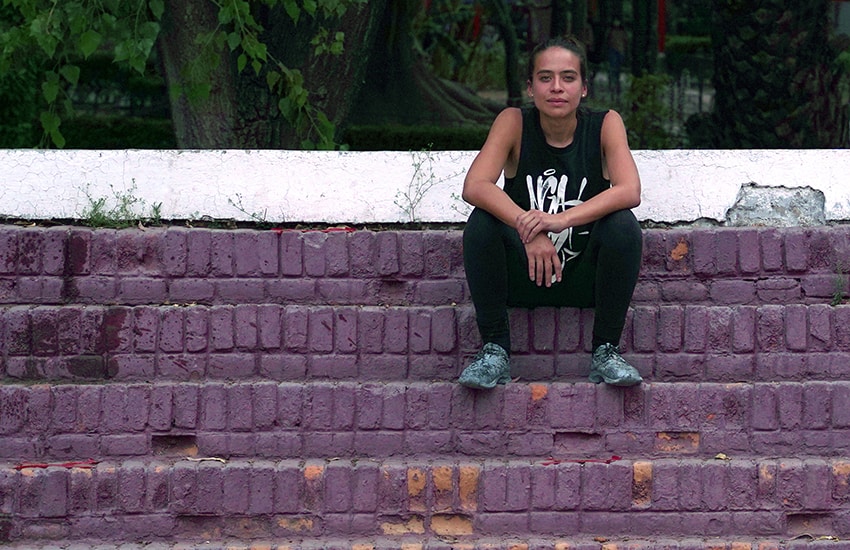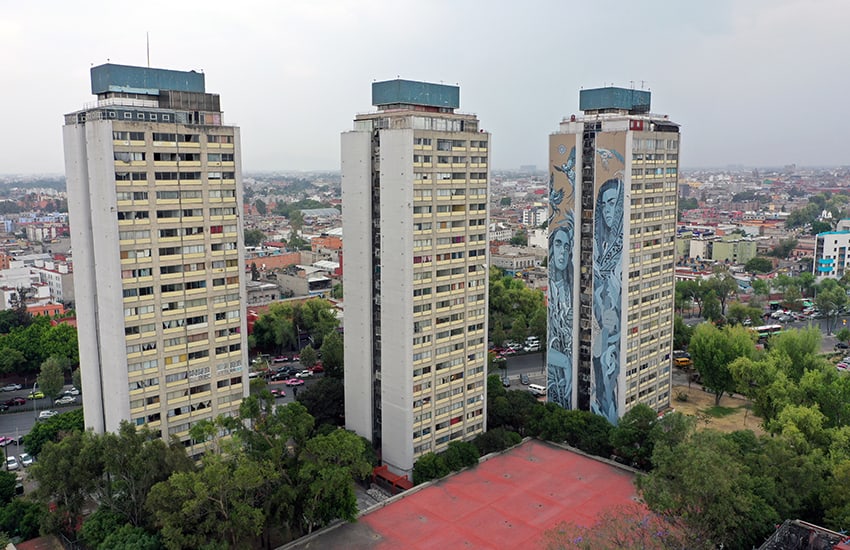It is 4:30 p.m., and the scene in the neighborhood of Tlatelolco, Mexico City, is vibrant and chaotic. Endless traffic lines the streets. Honks and sirens fill the air as locals bustle about, running daily errands.
Overlooking this disarray 20 stories up is a striking, vivid and lifelike portrait of two women surrounded by cornfields and magnificent, long-tailed quetzals. Their facial expressions, posture and stances evoke power, resilience and strength as they stare off into the distance.
About halfway up, right in the middle of the portrait, stands their creator, filling in the remaining strokes and shades of their color and essence. She does this fearlessly from a lift in mid-air, stroking paint and filling in gaps even as the wind shakes the lift a bit violently.
Paola Delfín is not afraid of heights, having worked on multiple large-scale pieces throughout her career as a renowned large-scale muralist and visual artist. She’s on a mission to complete the first of 17 murals for a project run by Colectivo ADN, an art collective in Mexico City.
The project looks at resurrecting the history of the archaeological site Tlatelolco as one of the largest markets in the Aztec capital of Tenochtitlán. It also sends an environmental message: all the artists are working with an ecological paint, Airlite, which actively purifies the surrounding air.

“It’s like you are planting trees at the same time as painting,” says Delfín.
Born in Mexico City, Delfín has been drawing and painting from a young age, when she could already see the potential of art as a form of communication.
“It’s always been easier for me to express myself through my work, through painting,” she explains.
She mostly worked on small illustrations and paintings during her early years, but nine years ago, she transitioned into muralism. She found using large wall spaces to be a perfect way to express herself.
“I try to push myself to really look at magical moments in my work because that’s why I do this in public. My work in the studio is different; I am just thinking about myself.”
In Mexico, murals have been used traditionally to spread visual messages to the illiterate population, allowing for greater community inclusion and cohesiveness. These messages promoted cultural identity, history and sometimes political or socially driven messages.
Delfín’s work draws on these same messages, focusing on unity and community. She believes broadly in the idea of using art, specifically large-scale public murals, to spark conversations and create reflection within her audience about their environment. Every one of her pieces looks over its respective neighborhood with a sense of protectiveness.
“My works talks about the connection between people, land, nature and their roots,” she says. Building cultural identity and protecting the environment are two themes she believes are essential to Mexican heritage but are sometimes forgotten.
At home, her urban murals communicate, express and create awareness and reflection for some of Mexico’s most challenging issues: loss of identity, poverty and the femicide crisis. She has designed art symbolic of Mexico’s feminist movement, specifically around the strength and power of women to build community.
Her murals also look at mechanisms that human beings can use to better humanity, such as empathy and bonding. She paints people primarily, so she has developed an innate ability to observe them and capture differences in thinking. Her murals can be seen in Latin America, Europe, Asia and North America.
Her largest piece so far, Shelter, covers a 40-meter-high building in Kiev, Ukraine. This piece was part of a wide-scale international project — Art United Us — which brought 200 muralists from around the world to work on messages of hope against war, aggression and violence.
Delfín finds knowledge and discovery in travel.
“I have encountered different ways of looking at life and how people think in other countries. That’s been really powerful for me because I have learned that there is way more than I can imagine in this world.”
In every country she visits, Delfín connects with locals who eventually become subjects or serve as inspiration for her pieces. She studies and talks to people from the area before painting.
“It is really important for me to make a proper story for each place I go to and paint. I have to connect with people because in the end, I am painting for them more than for me,” she says. “When I finish here, I might not come back for a while, but people are going to look at the painting every day.”
Through her public art, she hopes to reach a broad range of people, believing in making her work accessible without exclusiveness. She has joined efforts with other artists worldwide to educate youth on using art and painting to build community.
Delfín encourages the next generation to do things out of happiness and passion. “Break out of fear and find ways to do it,” she says.
Her earlier pieces explore inner and outer feminine beauty, strength and vulnerability, focusing on the female figure and facial features. She is shifting her work, however, toward inclusivity.

“With time, I understood that I need to say things universally. I need to include everyone,” she says. “If I am talking about equality, it cannot just be about women.”
Delfín is a person who thrives on change and doesn’t like staying in the same area, mentally and physically.
“It’s scary, but I like to experiment,” she says.
She is continuously experimenting with different techniques and formats. Her work is mainly influenced by illustrations, organic shapes and a mix of unconventional materials. She credits her inspiration to artists such as Remedios Varo and Leonora Carrington.
Recently, she’s made the move toward using monochrome to explore the absence of color, a shift in hue. She sees this change as “almost a kind of social experiment.” Painting with monochromatic tones has been interesting for her, to learn that “people are sometimes married to certain ideas of what murals should be, or what art should look like.”
The move away from color was influenced by her childhood work and the simple act of drawing in black-and-white pencil or charcoal for studio illustrations.
Delfín speaks openly about her challenges as an artist. “There’s this way of looking at artists that it is still not like a serious job,” she says.
She describes times when she has only been offered a beverage as payment. She wants the world to know that being a muralist is “a real job and a risky job” and that “it is not as easy as it looks.”
When she gets into a lift that climbs up a high building, she faces many challenges with wind, rain and heat.
She is otherwise grateful for her supporters — her family and friends, her artist networks and all the people she has worked with worldwide. She feels fortunate to have her work exposed for the world to see.
If people can understand what the message is about, [if they can] make their own conclusion about a painting, she feels grateful. In the meantime, she is learning to go with the flow.
“Sometimes projects just come from nothing, and they surprise you. So I am open to whatever happens next,” she says.
Mexico News Daily
